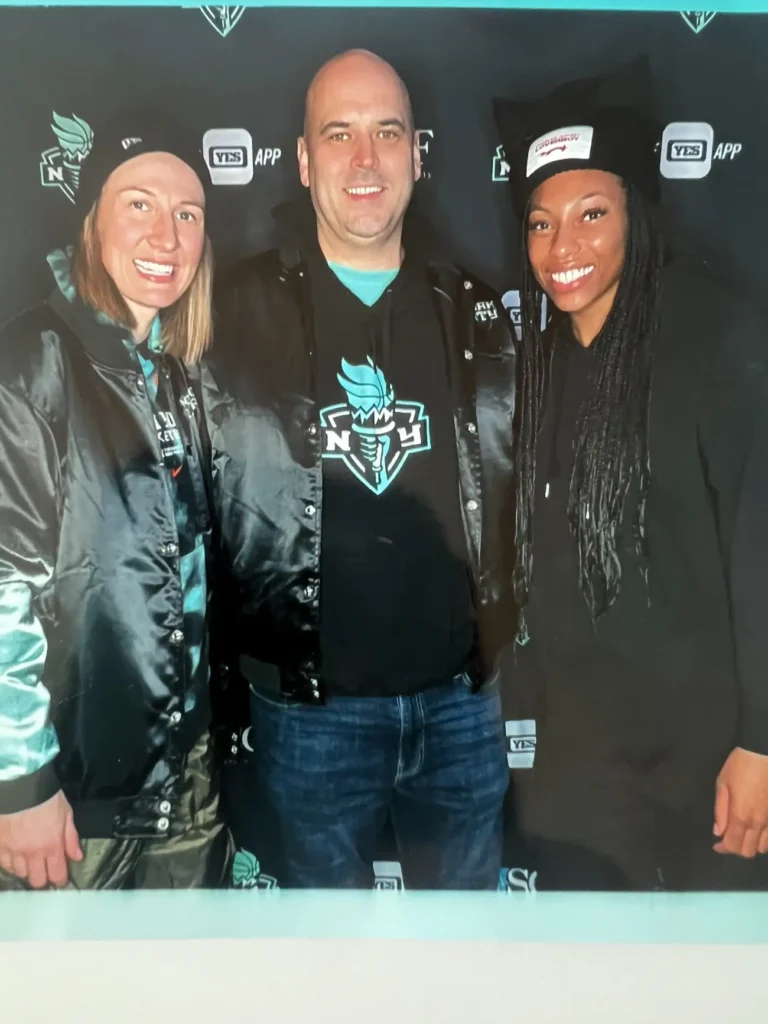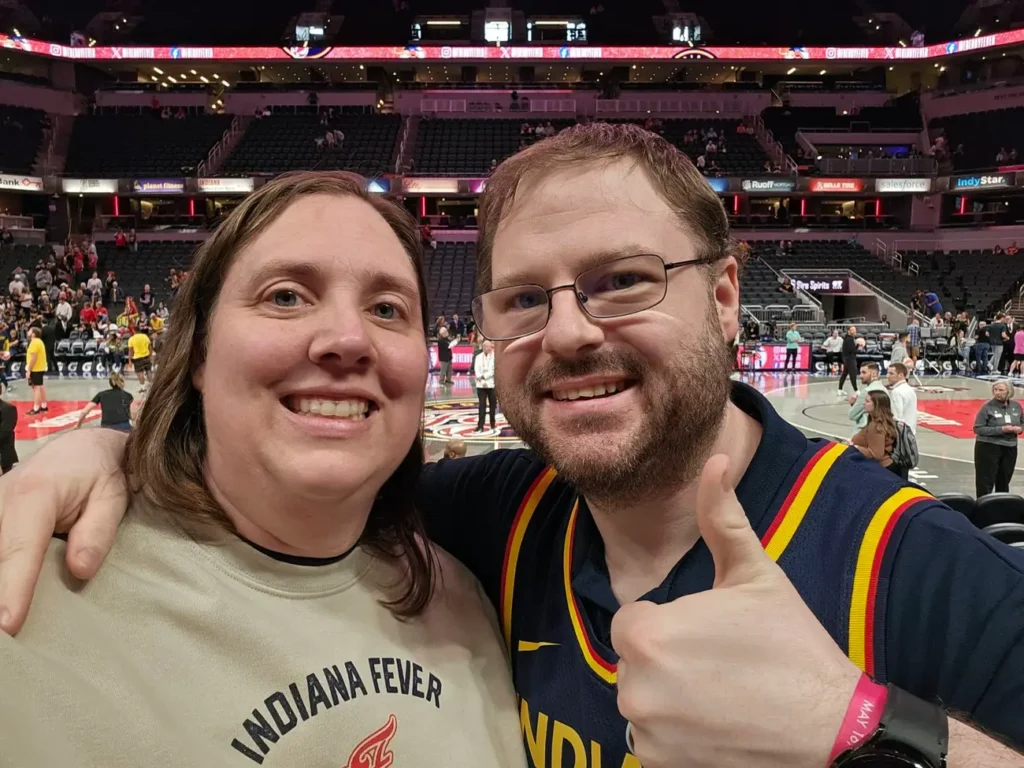The WNBA fan’s dilemma

WNBA fans have mixed feelings about the rising ticket prices that have accompanied the league’s spike in popularity.
In 2021, Dan Rodriguez was serving as an unofficial hype guy for his WNBA home team — the New York Liberty — which had just made the move to Brooklyn from White Plains.
The three-year season ticket holder bought 20 tickets for his own Twitter giveaway, hoping to encourage fans to show up and show out.
Turns out, even free tickets couldn’t get butts in seats. Many of the people who said they’d take one never even showed up, he told B-17.
Flash forward to 2024: A New York Liberty game against the Indiana Fever — basketball star Caitlin Clark’s team — brought in ABC’s most viewers ever for a WNBA game and reportedly yielded over $2 million in ticket revenue.
“The demand for tickets has just been so amazing,” Rodriguez said of this season. He added, “I can’t believe what it’s become and I’m so happy. I’m so proud.”

Dan Rodriguez (center) with New York Liberty Guard Courtney Vandersloot (left) and New York Liberty Forward Betnijah Laney-Hamilton (right).
It’s the type of whiplash that W fans, as WNBA enthusiasts like to call themselves, have been experiencing over the last few years. The effect has only been turbocharged by a superstar class of rookies and next-generation stars like Clark and Angel Reese of the Chicago Sky.
Clark, in particular, has quickly become a household name after her legend grew during a record-breaking career at the University of Iowa. She is a constant presence on ESPN and all throughout the sports-media landscape. Discourse around her stardom and budding rivalry with Reese generates endless online discourse.
Fans have shown they’re ready to splash out to see her play, and it’s raised the profile of the entire league.
The average price of WNBA tickets sold through the secondary market, before fees, has nearly doubled since last year — from $49.50 to $91.88, according to data provided to B-17 by the ticketing technology company Logitix. The data included all games completed through July 17, when the league paused its season for the Olympics.
WNBA average sold ticket price by team

For some fans, it’s bittersweet: The mainstream ascent of women’s sports is bringing eyeballs, media attention, and endorsement deals to athletes who have historically been sidelined in favor of their male counterparts. But it also has longtime fans worried that the skyrocketing ticket prices will leave them behind.
To be sure, the WNBA isn’t the only sports league where ticket prices have risen in recent years, as many Americans have flocked to live events of all kinds. However, the WNBA’s surging popularity — and its unique fan base — has left fans with a special case of sticker shock.
“It’s a byproduct of the great popularity of the league that’s happening right now. And so, there’s some drawbacks to it,” Rodriguez said. But, he added, “I didn’t think I’d see a time where they’d regularly sell out upper-level sections. Now they are on a regular basis.”
With hype comes high prices
The price for L’s pass to five Chicago Sky games this season rose from around $300 to about $500. Plus, the team is introducing “tiered pricing,” meaning that for partial package holders like L, some games will cost an additional premium to attend.
L said many of their friends opted out of renewing their season tickets.
“It’s kind of hard,” said L, whose name is known to B-17, but withheld over privacy concerns. “I actually made a document of pros and cons of all the different scenarios.”
Andrew Zimbalist, a sports economist at Smith College, told B-17 that other fans could be in a similar situation
“This is America. We have a market economy and when something becomes more popular and the demand for it goes up, prices go up,” he said.
David Berri, a sports economist at Southern Utah University who’s researched gender issues in sports, told B-17 that even if a team opted not to raise prices, its tickets would sell for the market rate on resale ticket platforms.
“Either the team collects the money or the people re-selling the tickets,” Berri said, adding, “There isn’t a real solution to this issue.”
Katherine Arnold, an Indiana Fever season ticket holder, has seen the demand firsthand. Like many season ticket holders, she can’t make it to every game, so she’s sold a few of her tickets throughout the season. She let her ticketing platform automatically set the pricing; tickets she originally paid $65 for ended up selling for between $450 and $750.
“I actually delisted our tickets because they were selling for so much,” Arnold said. “I actually felt bad about it.”

Katherine Arnold and husband Jeremey at an Indiana Fever game.
Berri said the WNBA’s ascent is following a “remarkably similar” pattern to that of the MLB, NFL, and NBA. He said each league saw low attendance in its first few decades before taking off.
“I can’t really blame the teams, the owners, for taking advantage of the popularity and trying to make additional money off of it,” Arnold said. But, she said, it “really sucks,” that higher prices can lock some fans out of games.
Rising prices fuel fan frustrations about player pay
Some fans told B-17 they’re willing to pay more for tickets but want higher prices to translate into higher player pay.
The WNBA’s annual salaries range between about $64,000 and $252,000, compared to roughly $1 million to $50 million in the NBA — even though the two leagues’ games have recently attracted a similar number of eyeballs. During the entire 2023-24 regular season, the NBA averaged 1.6 million viewers across its major television partners. The first month of the current WNBA season saw an average of 1.3 million viewers per game.
Despite fans’ frustrations, it could take some time before the financial rewards are fully realized for players.
Under the current collective bargaining agreement, only an estimated 10% of league revenue flows through to players’ salaries, Berri said — compared to 50% in the NBA. There’s been speculation that the players will opt out of the current collective bargaining agreement after the 2025 season, potentially setting the stage for negotiations over topics like the league’s revenue-sharing model.
Zimbalist said that when league revenues were lower, it arguably wasn’t financially prudent for teams to give players a bigger share of the pie. But times are changing.
“Eventually they should get up in the same 50% range that the NBA players are getting,” he said.
Despite the pay discrepancy, WNBA players have enjoyed some improved amenities this season. In May, commissioner Cathy Engelbert announced that the league would start charter flights for team travel.
Wondering if Caitlin Clark fever will last
The Indiana Fever’s recently released midseason report shows just how pronounced the Caitlin Clark effect has been. A few highlights:

But Victor Matheson, a sports economist at the College of the Holy Cross, told B-17 that the WNBA’s ability to ride the momentum is still up for debate.
“The real question for the WNBA is whether the Caitlin Clark mania is sustainable,” he said, adding that it remains to be seen how many fans who shelled out to see Clark’s Fever play will regularly attend games against other opponents.
When Indiana Fever games are excluded from the data, the average price of tickets sold through a secondary market, before fees, was $66.69 this season, per Logitix. When Fever games are included, it was $91.88.
Some WNBA teams have played in larger arenas for high-demand games so more fans can attend. This could, in theory, help bring down prices since larger venues increase ticket supply, said Patrick Rishe, a sports business professor at Washington University in Saint Louis.
“It’s a little bittersweet where it would be awesome to have a new arena, a little bit more professional than where we are now,” said Dave Elsea, a season ticket holder for the Las Vegas Aces — the W’s current reigning champs, and home to MVP-hopeful and W legend A’ja Wilson. He first became hooked on the team through their $10 tickets but said that his current season tickets run about $25 a game.
If there’s too much fan pushback to higher prices in the coming seasons, Holy Cross’s Matheson said ticket prices could moderate — teams use dynamic pricing models that adjust prices based on supply and demand. But as long as demand is strong, he said prices are likely to rise.
“Sports teams aren’t in the business of leaving money on the table,” he said.
But even if prices do rise, Smith College’s Zimbalist said teams will need to ensure tickets remain affordable for a wide enough audience.
“To really make the WNBA take off as a popular spectator sport, you’re going to have to involve middle-income Americans,” he said.
Dan Tamburro, director of ticket sales and service for the Connecticut Sun, told B-17 that the team’s ticket prices have generally risen this season due to strong demand and could rise further next season — though prices have yet to be confirmed. He said the team is working to ensure the tickets are worth the cost by offering perks like access to special team events for season-ticket holders or giveaways for casual fans.
Preserving a unique culture
The influx of new fans also means more than just pricier tickets. It’s a bittersweet paradox for some of the fans who take solace in the W’s uniqueness in the sports space: It’s a league that’s predominantly Black, and proudly queer. Now, it’s hitting a mainstream that doesn’t necessarily look the same.
Emma, a young Chicago professional and Sky season ticket holder, said she’s excited about the possibilities for players and the leagues from the influx of attention and money.
Her seats will cost 50% more next season. It’s important to her to see a concerted effort to both highlight and retain the diverse range of fans and players.
been,” Emma, whose last name is known to B-17 but withheld over privacy concerns, said. Emma believes that it’s important for the league to remain open to its commitment to racial justice and LGBTQ+ issues, both of which have been pushed by players and fans over time.
“I think that’s the main thing, is making sure that that sort of identity and that sort of pride and openness in that is not washed away in favor of something that seems more easily or more better or more seamlessly commercialized,” she said.

